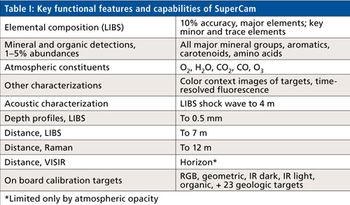
Spectroscopy
Our annual review of new spectroscopy products introduced at Pittcon, or during the previous year.

Spectroscopy
Our annual review of new spectroscopy products introduced at Pittcon, or during the previous year.

Spectroscopy
The SuperCam remote sensing instrument suite under development for NASA’s Mars 2020 rover performs laser-induced breakdown spectroscopy (LIBS), remote Raman spectroscopy, visible and infrared (VISIR) reflectance spectroscopy, acoustic sensing, and high resolution color imaging. The instrument builds on the successful architecture of the ChemCam instrument which provides LIBS and panchromatic images on the Curiosity rover, adding the remote Raman spectroscopy by frequency doubling the laser and using a gated intensified detector to obtain Raman signals at distances to 12 m. To the visible reflectance spectroscopy used by ChemCam, an AOTF-based infrared spectrometer is added to cover the 1.3-2.6 µm range that contains important mineral signatures. A CMOS detector provides color (Bayer filter) images at a pixel resolution of 19 µrad and an optical resolution of 30 µrad. Sounds are recorded via a Knowles Electret microphone, which is the same one that was unsuccessfully attempted on two earlier missions. The acoustic signals of the LIBS plasmas will provide information on the hardness of the targets, while other sounds (wind, rover sounds) will also be recorded. The laser, telescope, IR spectrometer, and camera reside on the rover’s mast and are provided by CNES, while the LIBS, Raman, and VIS spectrometers and data processing unit are built by LANL and reside in the rover body. A calibration target assembly provided by U. Valladolid, Spain, resides on the back of the rover. The overall mass of the instrument suite is 10.7 kg.

Spectroscopy
We will discuss three different types of ether, which are characterized by the type of carbons attached to the central oxygen.

Spectroscopy
Over the last few decades, elemental imaging using laser ablation inductively coupled plasma mass spectrometry (LA-ICP-MS) has emerged as an important tool in the study of solid samples from a variety of scientific disciplines, including medicine, biology, and geology. This article highlights recent analytical trends towards high-speed, high-spatial resolution, multi-elemental imaging that became possible with advances in both LA and ICP-MS technology, including the design of fast-washout ablation cells and commercialization of high-speed ICP-MS such as time-of-flight mass analyzers (TOFMS), This study will demonstrate the new imaging approach by coupling LA with an-ICP-TOFMS system (icpTOF from TOFWERK, Thun, Switzerland) on two application areas: quantitative mapping of trace elements in a sulfide mineral (sphalerite), and imaging of the distribution of a chemotherapy drug (Cisplatin) in a rat kidney. High-performance LA-ICP-TOFMS provides researchers with an effective new tool to study biological and geological processes, with much greater speed and in much greater detail than previously possible with conventional ICP-MS instrumental designs.

Spectroscopy
A straightforward numerical approach to estimate the performance of a spatial filter in Raman backscattering spectroscopy has been developed. This approach enabled the authors to determine an optimal hole diameter that balances spatial resolution and signal intensity.

Spectroscopy
Click the title above to open the Spectroscopy May 2017 regular issue, Vol 32 No 5, in an interactive PDF format.